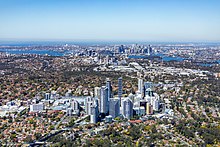Functional zoning
Functional zoning, functional city zoning, or use-based zoning is a method used for dividing land use by its function.[1] Typically, land use is divided in two ways, by its function and by its physical characteristics.[2] An example of functional zoning would be an area that has designated zones based on a function such as an industrial zone, a recreational zone and a residential zone.[1] An example of an area zoned by its physical characteristics is defined in terms of characteristics like development density, minimum lot size, and building coverage, placement and height.[1]
Functional zoning tends to create or increase car dependency, while mixed-use zoning tends to enable walking, making it more sustainable.[3] It has been criticized for causing the squandering of land, energy, and time.[4]
Single-use zoning
[edit]Separation between uses is a feature of many planned cities designed before the advent of zoning.[5] A notable example is Adelaide in South Australia, whose city centre, along with the suburb of North Adelaide, is surrounded on all sides by a park, the Adelaide Park Lands.[6]: 22 The park was designed by Colonel William Light in 1836 in order to physically separate the city centre from its suburbs.[6]: 22 Low density residential areas surround the park.[6]: 61

Sir Ebenezer Howard, founder of the garden city movement, cited Adelaide as an example of how green open space could be used to prevent cities from expanding beyond their boundaries and coalescing.[7]: 94 His design for an ideal city, published in his 1902 book Garden Cities of To-morrow, envisaged separate concentric rings of public buildings, parks, retail space, residential areas and industrial areas, all surrounded by open space and farmland.[7] All retail activity was to be conducted within a single glass-roofed building, an early concept for the modern shopping centre inspired by the Crystal Palace.[7]: 23
In 1916, New York City enacted the first city-wide zoning ordinance.[8] Zoning ordinances like this one went beyond the earlier city plans to create a process for setting guidelines for what could be built where.[8]
The application of single-use zoning has led to the distinctive form of many cities in the United States, Canada, Australia and New Zealand, in which a very dense urban core, often containing skyscrapers, is surrounded by low density residential suburbs, characterised by large gardens and leafy streets.[9] Some metropolitan areas such as Minneapolis–St Paul, the San Francisco Bay Area, and Sydney have several such cores.[10][11][12]
Mixed-use zoning
[edit]Mixed-use zoning combines residential, commercial, office, and public uses into a single space.[13] Mixed-use zoning can be vertical, within a single building, or horizontal, involving multiple buildings.[13]
Examples of mixed-use zoning include:
- Melbourne, Victoria, Australia[14]
- Baltimore, Maryland Baltimore, MD City Code, Art. 32 § 6-201 (2017).
- Saint Anthony, Idaho St. Anthony, ID Municipal Code §§ 17.06.090-17.06.120
References
[edit]- ^ a b c Dubrova, Stanislav; Podlipskiy, Ivan; Kurilenko, Vitaliy; Siabato, Willington. "Functional city zoning. Environmental assessment of eco-geological substance migration flows (PDF Download Available)". ResearchGate. Retrieved 2017-05-21.
- ^ Tyler, Norman (2011). Planning and Community Development. New York, NY: W.W. Norton & Company Inc. p. 188. ISBN 978-0-393-73292-4.
- ^ Carmona, Mathew (2010). Public places urban spaces: the dimensions of urban design (2nd ed.). London: Routledge. p. 222. ISBN 9781856178273.
- ^ Krier, Léon (2009). The architecture of community. Washington: Island Press. p. 105. ISBN 9781597265782.
- ^ Hirt, S.A. (2018). Split Apart: How Regulations Designated Populations to Different Parts of the City. In: Lehavi, A. (eds) One Hundred Years of Zoning and the Future of Cities . Springer, Cham. https://doi.org/10.1007/978-3-319-66869-7_1
- ^ a b c Adelaide Park Lands and City Layout: National Heritage Management Plan (PDF) (Report). Adelaide, Australia: Swanbury Penglase. October 1, 2023. Archived from the original (PDF) on 2024-03-25. Retrieved 2024-03-25.
- ^ a b c Howard, Ebenezer (1902). Garden Cities of To-morrow. S Sonnenschein & Co, reprinted by Dodo Press. ISBN 9781409950318.
- ^ a b Julian Conrad Juergensmeyer; Thomas E. Roberts (1998). LAND USE PLANNING AND DEVELOPMENT REGULATION LAW § 4.2, at 80. ISBN 978-1634593069.
in 1916 New York became the first city to implement this type of zoning law, later upheld in Village of Euclid v. Ambler Realty Co., 272 U.S. 365 (1926). "Operating from the premise that everything has its place, [Euclidean] zoning is the comprehensive division of a city into different use zones."
- ^ Whittemore, Andrew H.; Curran-Groome, William (2022-07-03). "A Case of (Decreasing) American Exceptionalism: Single-Family Zoning in the United States, Australia, and Canada". Journal of the American Planning Association. 88 (3): 335–351. doi:10.1080/01944363.2021.1985591. ISSN 0194-4363.
- ^ "What does the phrase 'The Twin Cities' refer to?". MPR News. 2021-12-08. Retrieved 2024-03-26.
- ^ "The Evolving Urban Form: The San Francisco Bay Area | Newgeography.com". www.newgeography.com. Retrieved 2024-03-26.
- ^ Falconer, Delia (2018-04-10). "The radical plan to split Sydney into three". The Guardian. ISSN 0261-3077. Retrieved 2024-03-26.
- ^ a b Mandelker, Daniel R., Zoning for Mixed-Use Development (July 14, 2023). 58 Real Property, Trust and Estate Law Journal, Spring 2023, Washington University in St. Louis Legal Studies Research Paper No. 23-07-01, Available at SSRN: https://ssrn.com/abstract=4510458
- ^ "Commercial 3 – Victoria's new zone for mixed use and creative industries". The Fifth Estate. 2018.
